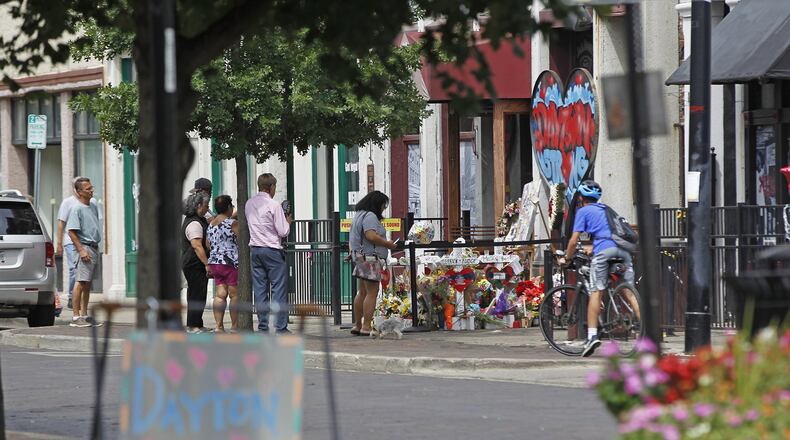The newspaper also learned more about the drugs found in the shooter’s body, though police wouldn’t say when asked Friday whether the killer was legally prescribed the anti-anxiety drug Xanax found in his body, or if he illicitly obtained it. Experts said the drug is commonly abused alongside cocaine, also found in the gunman’s body, because it allows those who abuse cocaine to more easily fall asleep.
INVESTIGATION: Oregon District gunman left decade of red flags
Police also wouldn’t say if they’ve spoken to the person who wrote the receipts about whether gunman Connor Betts, 24, provided any indication in counseling that he was contemplating the massacre that killed nine people before police killed him.
Betts’ friends have said in multiple Dayton Daily News interviews that the man had a fascination with mass shootings and urges to hurt people.
Counselors hands can be tied
Ohio law requires mental health counselors to take action in certain circumstances when someone threatens themselves or others. But it only applies if the threat is to a specific person or place, and the action the professional takes doesn’t necessarily involve alerting law enforcement, according to the executive directors of Ohio’s two state-run mental health professional licensing agencies.
The three receipts were among numerous possessions on the gunman’s body, the Dayton Daily News found in an examination of preliminary autopsy results. Those results typically include photographs of items found in a person’s wallet or pocket.
Rips and bloodstains made the handwritten receipts difficult to read, but the newspaper saw each was for $50. Dates on two were for April 5 and June 10, but the date on the third receipt wasn’t visible.
Ohio law says mental health professionals may be liable for civil action or have action against their licenses for injuries or death if they fail to respond to a threat. But the threat must be “an explicit threat of inflicting imminent and serious physical harm to or causing the death of one or more clearly identifiable potential victims,” and the professional determines the patient has the intent and ability to carry out the threat.
MORE: Dayton gunman discussed shooting up UD bar, friend tells police
This means the law doesn’t apply if a client says they intend to hurt or kill people in general, said Ronald Ross, executive director of the Ohio Board of Psychology. It’s not a mandatory reporting law, Ross said, but rather “a duty to do something under certain circumstances.”
In such a case, the professional must take one of several actions. Those could include alerting law enforcement and the potential victims, or hospitalizing the patient or establishing a treatment plan “to eliminate the possibility that the client or patient will carry out the threat” after getting a second opinion. Whichever action the professional takes must be documented.
“They do have some options under the law, and that’s where their professional judgment and experience, as well as that of any other mental health professional in the situation, would be applied,” said Brian Carnahan, executive director of the state Counselor, Social Worker and Marriage & Family Therapist Board.
Both board directors said a professional could risk their license for reporting too vague a threat, but the licensing board members would weigh all the circumstances to determine if the professional made a reasonable decision in the interest of public safety.
Both said no professionals have had action taken against their licenses in recent years by the boards for either improperly reporting or failing to report a perceived threat.
Drug use comes into focus
Experts said it’s unclear how the combination of drugs in the gunman’s body would’ve impacted him. The coroner also found the presence of alcohol. A full toxicology screen isn’t yet completed, so the coroner couldn’t yet say how much of each substance was detected.
Alcohol and cocaine both leave the body quickly, so he likely consumed those shortly before the shooting, said Melissa Beck, a toxicologist and professor in the Cedarville University school of pharmacy. Xanax, the brand name for alprazolam, can stay in the body for weeks.
Alcohol and Xanax are both depressants, and cocaine is a stimulant, though combining alcohol and cocaine can produce a longer-lasting stimulant effect than cocaine use alone, Beck said. Also in some patients, she said, Xanax can have the opposite of its usual effect and cause aggression.
“It’s possible that it had sort of the opposite effect, and combining that with a couple of stimulants would have some significant effects on the person,” she said.
MORE: Dayton shooter hid gun, ammo from parents, new documents allege
In one surveillance video, the gunman is seen either smoking or vaping before the shooting, though police wouldn’t say if they’ve determined which substance he was consuming.
Ethan Kollie, the man who purchased Betts’ body armor and weapon parts and is now facing unrelated federal charges, “informed the FBI that he and Betts had done ‘hard drugs,’ marijuana, and acid together four to five times a week during 2014 to 2015,” according to a federal complaint.
Another friend, Will El-Fakir, told the newspaper he knew Betts had used hard drugs, including meth, several years ago.
“He was definitely not in a right state of mind,” El-Fakir said of Betts during that time. “He was using a lot.”
In a letter she wrote after the shooting, former girlfriend Adelia Johnson detailed one experience she had when Betts called her in March or April. She said he was “super drunk” at a band gig in Illinois.
“I couldn’t understand what he was saying … I did catch bits and pieces among his topic jumping that he wanted to hurt a lot of people,” she said. “He didn’t have any specific plans. I wrote it off as being a sad, drunk man who was afflicted by unchecked symptoms of mental illness.”

